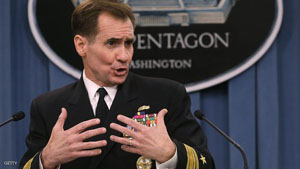Washington, Oct 7: The US today said it does not support declaring Pakistan a 'terrorist state' but will continue to work with the governments in the region to eliminate safe havens which also pose a threat to India.
 The US also called for a "meaningful dialogue" between India and Pakistan to address differences including the Kashmir issue and to bring down the recent tensions.
The US also called for a "meaningful dialogue" between India and Pakistan to address differences including the Kashmir issue and to bring down the recent tensions.
State Department spokesperson John Kirby, however, expressed confidence that Pakistan has kept nuclear arsenals safe from terrorists.
Asked if the government would support a bill in the Congress and an online petition that the US should declare Pakistan a 'terrorist state', Kirby at his daily press briefing said: "I have not seen anything specifically about the – such a bill, and obviously we don't."
He, however, said he would not comment on "whatever pending legislation may be coming in that regard". "What we – what I would say is common threat, common challenge in the region, and we're going to continue to work with Pakistan, with Afghanistan, and the Secretary (of State) just came back from Brussels and the Afghanistan conference in Brussels. And obviously it's a threat to the Indian people as well.
"So we're going to continue to work with the governments in the region to try to address these common threats and challenges, and we've always said that more can be done about the safe havens and that's – we're going to, again, try to work as cooperatively as we can to that end," Kirby said.
He said the US' position on Kashmir has not changed and it is for India and Pakistan to address the problem.
"On the Kashmir issue, our position has not changed. We want this to be worked out between both sides, the issue of Kashmir. And generally, we obviously want to see the tensions that exist right now be brought down and for dialogue to take its place – meaningful dialogue to try to address these issues bilaterally between the countries," Kirby said.
He added that the US wanted India and Pakistan to resolve their differences."There are still differences of opinion that exist between them; and as I said earlier, we want them to work through those differences. We have differences with many countries too, and we continue to try to work through them," Kirby said.
"That's all we're asking, that's all we're hoping, that's all we're expecting from leaders in India and Pakistan. But we don't believe for a minute that they don't take the challenges before them seriously or the lives and security of their children," he said.
Kirby also said the US had full confidence in Pakistan's nuclear security."I think we've said before we're confident that Pakistan has the security controls they need to have in place on their arsenal," he said.





Comments
Add new comment